Quest Z: The Black Omen
Stat of the Quest:Of the non-boss enemies leading up to this quest, only 35% must be fought. That means most of the enemies in the game can be avoided entirely! Sometimes it�s difficult to do, but it�s possible to fight very infrequently in Chrono Trigger--up until the Black Omen. Inside the Omen, 71% of enemies must be fought. It�s another way the designers used gameplay mechanics to embellish the artistic effects of the game. The Omen feels long, arduous and climactic because of the unavoidable battles!
The Black Omen is a final dungeon in the mode of most final dungeons: lots of tough enemies, a few useful end-game items, a handful of bosses, save points aplenty, and an escape route. A lot of these things highlight trends in Chrono Trigger that make the game remarkable. For instance, we expect there to be dozens, if not hundreds of medium-difficulty enemy encounters on the way through a final dungeon. The Black Omen doesn�t disappoint; there have been dozens of encounters in several dungeons in Chrono Trigger and the Black Omen is the biggest of them all. But in every other dungeon in the game, most of those encounters were avoidable. This is a natural product of enemies being on-screen instead of being random encounters; some enemies can be seen and evaded. (In fact, some enemies who were not meant to be evaded can still be evaded. Programmers are only human.) 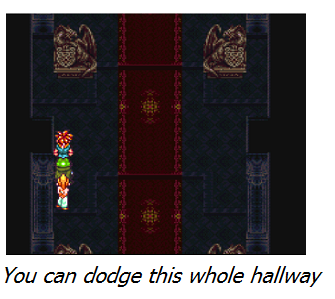
In fact, as we noted in the header stat, only a minority of the enemies in the game must be fought, as long as we�re not counting the Black Omen. Again, some of this is programmer error, like the third sequence of battles in Magus Castle--all of which are avoidable even though they clearly shouldn�t be. But most of it is just something that players are allowed to do. It wouldn�t make for a good game on the theme of inevitability if all enemies were uniformly inevitable, would it? The Black Omen, on the other hand, is filled with unavoidable enemies. It�s hard to say whether there�s a message encoded into that, but the player will feel the difference from even the most climactic dungeons of the earlier game.
The Black Omen brings back the tech-only enemies design idea, but in a novel way: the enemies are damage sponges. It�s quite a marked change; virtually every enemy in the Black Omen has so much HP that hitting them with dual techs is necessary. The most damage a player can expect to see out of a normal attack (on any regular basis) is Crono�s frequent critical hits with the Rainbow, dishing out about 1500 with good luck. Before the Omen, there were only 8 enemies with that much HP, all of them in Giant�s Claw, and none of them terribly hard. In the Black Omen, there are 49 monsters with more than 1500 HP. This means that dual techs (being way more cost effective than single techs--as we�ll see later) will be necessary constantly. With copious save points, this isn�t unreasonable, but it�s still necessary that the player figure out which dual techs are the most cost efficient, and which can actually kill a bunch of beefy enemies.
Although enemies are drastically more powerful, Chrono Trigger shows its populist stripes when it comes to the first 3 bosses. Although underleveled and undergeared players will be shredded by the Mega Mutant, none of the Mutant bosses are terribly difficult at the appropriate level. The only real problem is the confuse debuff, but there�s an awful lot of gear to cancel that out, much of which has no tactical drawback that would prohibit its use. The latter two mutants can only be defeated with magic damage. This presents a question, rather than an insight, into the design. Did the designers think that physical double and triple techs would so dominate the game that these magic-only bosses would present a real problem? The only party badly undercut by magic-damage-only bosses would be Crono, Frog, Ayla. Indeed, most Crono / Frog parties are fairly weak in these fights, but not untenable with good gear and the right level. What was the point for anyone who used Lucca or Marle, though? There�s not really an equivalent in terms of purely physical boss fights. The Retinite took only physical damage, but had a magically triggered vulnerability. That�s not bad, but it�s not a straight say-no-to-magic brawl because of the vulnerability. And the Son of Sun was a no-magic zone, but he was a puzzle boss rather than a physical boss; bringing Lucca and Marle would have worked just fine. So much for forcing the player to shuffle their party composition for physical power.
We�re going to skip the Lavos Spawn, as it�s mostly just a pumped-up version of its forebears with a few additional attacks, and has nothing on the next few bosses, all of whom are bit more interesting.
Queen Zeal�s first form is a kind of jump-scare boss, designed to wear on the player�s nerves (and perhaps their supply of megalixers). Zeal�s primary move is to cast Hallation which (1) is not in the dictionary and (2) reduces the entire party�s HP to one. She rarely, if ever, follows this up with quick attack. In such cases as she does actually make a second move, it�s typically an MP-draining attack, which seems to indicate that this fight is designed to make the player spam items like Elixirs and such. It�s actually not a hard boss fight, but it certainly sets a dire tone for the fights to come.
The Mammon Machine is another magic-only fight, although it might take players a round or two to figure this out. Because almost every party member will have a high magic defense (the average is 82 at level 50, without any supporting items) it�s not a hard battle, and it�s not very interesting; the Machine gains power from magic attacks and defense from physical attacks. It�s kind of a design fail on the part of Square, this time. Interestingly, though, they would attempt the same fight as one of the last battles of Xenogears. (The Opiomorph battle, if you recall, uses a very similar reaction mechanic, but is much harder.)
Queen Zeal�s second form is a wonderful twist on the player�s recognition of bosses and appropriate strategy.
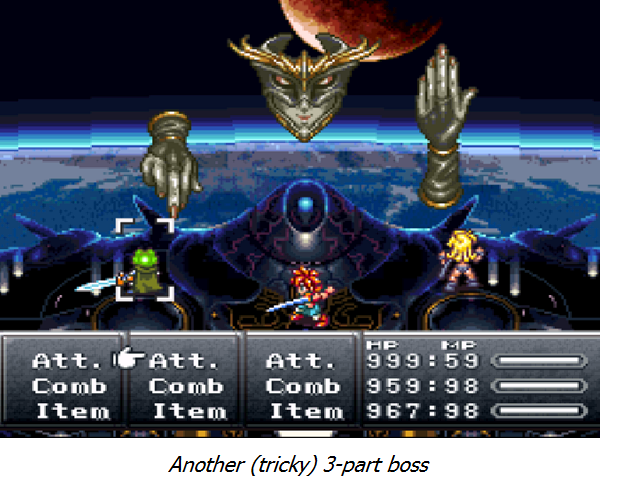
�Hey!� players tell themselves. �A three-part boss! I should kill the hands first.� Of course, this is a disastrous idea. Both hands respond to damage with wipeout attacks (for MP and HP) and are actually not a threat at all. Unlike Giga Gaia and the Guardian, Zeal�s second form can and should be defeated by concentrating on the head. The designers are having a bit of a laugh at the player�s expense, there. Add to this that Zeal�s second form can use Hallation and then actually follow it up with a damaging attack, and the battle is as hard as it really ought to be. (Which is to say, not that hard, but hard enough.)
LAVOS
Here�s a list of design ideas that the three forms of Lavos employ:- Wipeout attacks
- Status attacks
- Attrition attacks
- Three-part boss structure (a bunch of times)
- Sequence of battles (of bosses!)
- Triggered vulnerability
- Tech-only enemy (too much HP to use normal attacks)
That�s almost everything. And with a total of over 100,000 well-guarded HP, it wraps the game up nicely, doesn�t it? But let�s dig into how they do it.
A good amount of credit should be given to the designers for doing with Lavos everything they really needed to do. They needed to make him the most challenging enemy, and yet not too challenging. They needed to make sure that all those tactics they taught and spot-checks they placed actually resulted in a big payoff. They also needed to make sure--since this is the essence of the Comedy of the Sages--that the plot and gameplay were especially harmonious. Fortunately, they managed to do all of this. Lavos is definitely the hardest fight; really he�s the hardest series of fights because there are up to three very different encounters with him, depending on when and how you engage the beast. (Hey, that makes it a sequence of battles... boss style!) It�s also, true to form, not an exceptionally dangerous fight; instead it gets its climactic feeling from the fact that Lavos has a lot of HP to whittle away.
As for the issues of using all the game�s skills and being harmonious with the plot, the designers took care of both of those things at once. Lavos is supposed to have assimilated the essence of every other creature on the planet. It follows that he should use virtually every ability or tactic seen elsewhere in the game; and for the most part he does. Obviously this happens in the boss rush that begins the battle. This is a little cheesy, but at least there�s a reason why the designers would throw this at the player. Following that, Lavos�s first authentic form is a high-powered attrition boss that uses occasional confuse/chaos debuffs.
Lavos�s second and third forms are very similar, in that they both do a lot of different things. Both of them, ultimately, are three-part bosses protected by triggered vulnerability. The second form requires that both arms die before the head becomes vulnerable.
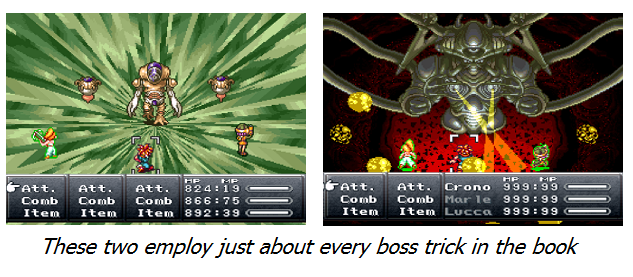
Lavos uses a number of fast attrition attacks, like Doors of Doom (medium multi target damage) and Flame Battle (single target) and Shadow Slay (light attrition). Additionally, there is a massive wipeout attack he uses at the end of his rotation once the arms are dead and the head is vulnerable: Shadow Doom Blaze. One other interesting point: Lavos Part 2 will disable status defenses, meaning that we finally have another boss that uses status debuffs in a threatening way again, since he also includes a multi-target confuse debuff in his rotation. (We haven�t seen this, really, since Flea.) It seems as though the designers came into the game wanting to use status debuffs in a threatening way, but decided that it wouldn�t do, and so reduced the incidence of meaningful status attacks to only a few bosses. Whether or not that�s the case we can�t infer from the design.
Lavos part 3 uses triggered vulnerability too; essentially it�s the most refined form of that design idea in the game. In what is effectively a cross between Giga Gaia/Guardian and Nizbel, the �active life� (the head, more or less) cannot be damaged unless its vulnerability is exploited. That vulnerability requires that the player kill either the top or left pieces of the triad, which will then regenerate like the pieces of Giga Gaia or Guardian did. Unlike those other bosses, however, there�s not a horribly devastating multi-target counterattack for hitting the �head�. The lack of a counterattack owes to two things: first, the �head� looks like one of the hands, and is not at the top. If there were a devastating counterattack, the player could easily be wiped out and have to kill Lavos part 2 again (which would be supremely annoying, if it happened on a gimmick like that). Secondly, the boss uses a cycle of wipeout attacks, which would combine horrendously with a devastating counterattack.]
Lavos Part 3 eschews normal attrition in favor of two wipeout attacks. Grand Stone and Dreamless are, respectively, physical and magical wipeout attacks that can definitely do the job. But while there�s no real attrition attack in the conventional (frequent, low-damage) sense, there is a status debuff that has a damage component. Invading Light is medium damage and adds a slow debuff to the entire party. There�s also a random status ability, although without a frequent status-defense remover, it�s probably wasted. The only other attack of note is the left bit�s ability to steal MP. It�s not much, but it can be meaningful when the player goes to heal and lacks the MP to do it!
(Interesting side note: if you think about it, the Time Devourer from Chrono Cross is actually an even more highly refined version of the triggered vulnerability idea. In order to defeat him the �proper� way you have to execute several specific attacks in a very specific order, or else he�s not vulnerable to the �right� attack. It�s a little complicated. But it�s cool to see that the CT designers were still thinking through that design idea years later!)
Strengths and Weaknesses in the Design of Chrono Trigger
(1) The Problems of Audience.
Casting a Wide Net
Chrono Trigger is a game designed for a very wide audience. In the mid 90s, Squaresoft knew that they had the talent, resources, and market position to begin making JRPGs for people who didn�t ordinarily play them. As such, most of the strengths and weaknesses of the game--at least those not already discussed--arise out of a desire of the designers to include a broad audience of greatly varying levels of JRPG exposure. The greatest strength and biggest weakness, in this regard, is that the game is not very hard. To experienced players, the game is too easy. (If the last JRPG you played before this was Final Fantasy 5 or something of that era, Chrono Trigger is laughably easy.) But to new or casual players of JRPGs, the game is moderately difficult, with most of the challenges coming at the major boss fights. There�s no real case of �that one boss� or �that one level� which can�t be solved by any conventional strategy; a few deaths worth of learning, or a few levels worth of grinding can almost always solve the problem in short order.
The prevailing reason why the game is occasionally too easy is the abundance of powerful, cheap dual techs. As a rule, dual techs are both more powerful than the sum of their component abilities, and significantly more MP efficient. For example, at level 40, the combined damage floors (close estimate of minimum damage before randomness is figured in) of Fire 2 and Confuse is about 1943 points. Fire Sword 2, the product of those two abilities as a dual tech, has a damage floor of about 3240. The same is true for single-target spells that become multi-target as a dual tech. At level 20, Marle�s Ice and Frog�s Water spells would add up to a damage floor of a little over 300--and that would be against only one target. The product of those two spells, Ice Water, would do the exact same damage to any number of enemies on the screen, potentially netting as much as 1800 in a single cast, for the same amount of MP total.
Below is a graph detailing the average damage per MP spent for dual techs vs single techs at levels 20, 40 and 60.
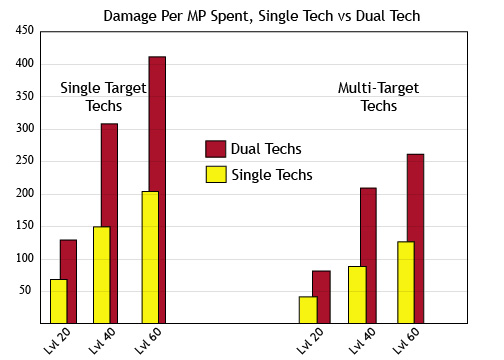
As we mentioned before, the place where this dual tech power surge peters out is in the Black Omen. The enemies there have so much HP that normal attacks are almost never a viable option, and so the power of dual techs becomes the baseline because of inflation. That�s only one dungeon, though, and it�s the last dungeon. The question is, what alternative did the designers have in making Chrono Trigger difficult? The second half might have been a bit harder in places, but it would be difficult to radically alter it without changing the voice of the Comedy of the Sages, which is not something the designers were going to do. They wanted the second half to feel varied; challenging, but forgiving with lots of exploration-style quests. So there really wasn�t room for adding tactical drawbacks to techs, categorical immunities for enemies and that sort of thing.
History has later shown us what the designers would add in later releases of Chrono Trigger: an extra challenge dungeon. I contend that the design team could not do this for the original, however, even if they�d wanted to. We�re not about to delve into that extra dungeon here; it wasn�t in the original game, and we�re whores for canon. That said, the idea is to add completely optional (doesn�t affect the ending or new game plus criteria) content that is very hard for players who want to try it out. Chrono Trigger existed at a time when this was still mostly incompatible with an RPG specifically made for a very broad audience and a production budget that was less than infinity. Optional, super-hard dungeons did already exist, and had for a long time. But Chrono Trigger changed the way the industry and players saw the JRPG so much that every feature we would have liked it to have is one that was later developed because of the popularization Chrono Trigger achieved. Puzzle that one out if you like, but the takeaway message is that there�s no radical step that the Chrono Trigger team could have taken without first making Chrono Trigger.
Stopping to Get Directions
N.B. If you have not yet read Reverse Design: Final Fantasy 6, you may want to consult page 5, in which we discuss NPC sociology and NPC irony. Without an intro to these concepts, what is written below won�t make much sense. NPC irony is not like regular verbal irony, and understanding it as such will mislead you. NPC irony is about the designers communicating something about the gameplay to the player without breaking the narrative spell. The full definition is not worth repeating in this essay; see the other document for reference. If you like RPGs, you will be entertained--we promise.
Chrono Trigger is not abundant in different forms of NPC irony; overall it is less than both the games we measured before, and more one-sided. The NPCs of Final Fantasy 6 and Majora�s Mask offer ironic dialogue about 35% and 55% of the time, respectively. Chrono Trigger is somewhat close to FF6 at about 31%, but the problem is that almost all of this ironic communication takes place as direction. Chrono Trigger�s NPC sociology reveals a rate of just over 24% direction dialogue. FF6, by contrast, had only about 13% directions and Majora�s Mask, another complex game about time travel, had only 18%. The big difference is that FF6 and Majora�s Mask both had about 17% of the total NPC dialogue come as allusions whereas Chrono Trigger is only about 6% allusions.
This one-sidedness in Chrono Trigger is another result of a game being designed for a very wide audience. Final Fantasy 6 might have been an attempt to make the series more popular among non-core gamers, but it nevertheless retained a large number of design ideas suited to experienced RPGers. One of these ideas was the quest allusion: an NPC tells the player about a quest, but leaves out part of the information. The player then has to figure out what the final piece is, so as to uncover the start (and/or end) of that quest. Experienced players of RPGs have learned, across the course of many games, how to intuit the missing parts of quest allusions. For them, the puzzle is a brain teaser that, when solved, results in a rush of intellectual satisfaction in addition to tangible quest rewards. If Chrono Trigger was really supposed to include inexperienced RPGers in its audience, it had to minimize the use of allusions.
Another couple of reasons why allusions might not work for Chrono Trigger are the obvious inappropriateness of talking to NPCs about another era, and baseline complexity of time travel. Except for a few cases, NPCs do not refer to quests and such outside their own era. Why would they, really? How would anyone, save an archaeologist or famed explorer, know enough about another era that they could then tell the player how to do something as specific as go on a relevant quest? It would be absurd, usually; and so Chrono Trigger does not do that. A more gameplay-centric reason is that Chrono Trigger would be quite complex if NPCs didn�t give heavily ironic, obviously directed indications of where to go. Would any player, experienced or not, want to have a game where every quest is as tricky as the Sun Stone quest? That was fun once, but it would probably get annoying if repeated too often.
(2) Characters and Music
It is not necessary to have well-developed characters to make a great game. Chrono Trigger�s characters are rather one-dimensional, but they work just fine. They start as cool, catchy, likeable stereotypes and they end that way; there isn�t much development. We come to understand the underlying motivations of Frog and Lucca, but those motivations are about as one-dimensional as the characters themselves. There are hardly any long, laborious scenes that highlight the lack of depth to these characters, though, so this one-dimensionality isn�t a problem. This certainly spares Chrono Trigger the fate of many later Final Fantasy games, where the player base is divided by either a love or hatred of the main characters. There�s enough of the Chrono Trigger characters to like, but not really enough to hate. The caveat that emerges from this is that if you, as a designer, are going to create one-dimensional characters for your videogame, it is probably a good idea to be judicious about it, because there�s nothing worse than flat characters who have entirely too much to say.
Chrono Trigger pulls all of this off because the characters are able to be themselves, move the plot, and do so in very short order. If you count only the quest content of the game--starting when Crono arrives in 600 AD and you don�t include the endings--the average number of words spoken by a character before they are interrupted by someone else is about 7.3. The Median number of words spoken for characters is 5. This means that most of the dialogue is a kind of quick back-and-forth between characters, and occasionally some ripostes with enemies. The big, speaking enemies (Magus, Azala, Ozzie, Dalton) tend to speak less than 9 words before someone else jumps in. There are some longer speeches, because variety is necessary too, but generally the designers knew that they had to keep the speeches short and the game moving. You can see a visualization of how they did this, below.
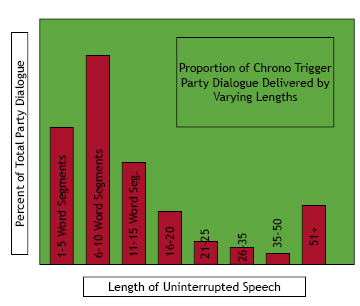
(NPCs appearing in the script are different; they tend to say more words in a single pass, and they exhibit a great variety of lengths. This, however, is because NPCs are usually handing out quests, which require sustained explanation. It�s awfully hard to tell the player what to do in 7 words.)
With all of this being the case for the characters, the Square team were very fortunate to have the right man on the job, musically, in Yasunori Mitsuda. Most musicians have are stronger in one aspect of their craft than others, and Mitsuda, though enormously talented, is not a character man. To be fair to him, most actors and most writers can�t really portray every single character well, so why should we expect that musicians should? Nobuo Uematsu absolutely nailed most of the characters for Final Fantasy 6 (see that write-up here) by encapsulating their stories. Uematsu, at his best, is able to capture a large range of emotions in a big story, and somehow compress them. (Listen to Cyan�s Theme or the Final Fantasy 7 Main Theme, you�ll hear it.) For characters that experience a lot of development, this is great! The music reminds us of the whole character. But Chrono Trigger�s characters undergo very little development, and so Yasunori Mitsuda is able to concentrate on other things.
Mitsuda�s gift is almost the opposite of Uematsu�s: Mitsuda is very good at accurately expressing the mood of a single moment. Specifically, Mitsuda is able to fully comprehend the meaning of a moment, and to delve deep into the most authentic emotion that the moment should elicit. He goes way beyond, �sad� �happy� or �frustrating� into extremely fine shades of emotion that are incredibly specific to the moment at hand. At his best, Mitsuda is able to so accurately isolate a complex emotion that it can be difficult to describe in words what Mitsuda is describing in music. Fictional humans--and maybe a few robots, reptites, and other creatures--experience a variety of these emotions, so Mitsuda�s style is not the best musical vernacular for explaining round characters. What we get instead are really great snapshots of characters that embellish the one-dimensional coolness of the characters, rather than fleshing out their other aspects.
Lucca�s theme is highly illustrative of this snapshot approach to character. Lucca�s theme plays for the first time when she opens the first gate in 600 AD, and then revels in her accomplishment. This is clearly the most appropriate moment for that tune. We have a straight fanfare for the first 4 seconds, after which comes what we might call the actual �theme.� That theme consists of three parts which, I think, identify Lucca�s feeling at this moment really well. The trumpet, playing the melody, continues a fanfare theme: it sounds impressive, showy, victorious. On the other end, the bassline plunks out a steady, mechanical, orderly eighth-note cadence that grounds the tune. These are both qualities you�d expect from Lucca at a time like this: showy genius and logical composure. The best part of the tune, however, is what�s sandwiched in between the bass and the melody. Listen closely and you�ll hear a mid-range rock organ. The organ plays an irregular beat. The eighth and sixteenth notes are syncopated and their phrasing is irregular, relative to the rest of the tune; then they terminate in a straight triplet. It has a kind of stuttering, frenetic feeling. Between Lucca�s brash achievement and her coolly logical scientific side, you can hear the barely-controllable nerdy giddiness that she really doesn�t want other people to see. But what nerd hasn�t felt that way, trying to seem cool while handing out some serious knowledge--even though it�s more exciting to you than the audience?
But does this describe Lucca totally, or offer insight into her character? We know that Lucca doesn�t always feel this way, and so we know that her theme is probably more suited to a moment than to a person. That said, it works as a theme for her pretty often. This speaks to the one-dimensionality of the characters, and the fact that we�re not really meant to get a lot of insight into them; the meat of the game is elsewhere. A lot of the themes are that way. Marle�s theme hardly makes sense for her character except in a few moments�it�s great for the moment it appears in, but too soft to describe her personality; although she has her tender side it says nothing of the majority of her actions in the game. Robo�s theme is the same way: it works perfectly as a �Hey, I just found a humanoid Robot, and he�s cool!� but hardly describes the oddly sensitive robot as he appears in most scenes. Crono�s theme is the main theme; that makes sense he�s more or less an anime marionette/player avatar. You wouldn�t want him to have some alienating hidden depth.
Schala�s theme doesn�t really capture her character either, but it does something much more interesting. Listen to the track: it�s great but it hardly reflects her personality or her personal struggles at all. Obviously Schala is in a position to be troubled about her kingdom and her family, but that�s not what the music says. The way that the crystal synth chimes out the beat is exotic and enchanting--not troubled. You can hear the graceful sway of Schala�s walk in the way the crystal strikes chords only on alternating beats. The haunting oboe line above it jumps around on 5ths, and leaps an entire octave on a Bb the first time through the melody--all of it natural to the Bb minor scale. It�s not the close clusters of notes or frequent accidentals you�d expect from tension. The melody resolves over an open 5th Bb chord, no minor third audible. If anything the track is elegiac and forlorn, mourning the unrecoverable loss of something beautiful, ending in a perfect fifth, sounding like numbness. This is what we�re supposed to feel about Schala--this is how Magus feels when he remembers her. It�s not how we, as the audience, are supposed to understand her experience as a character.
That�s Mitsuda�s gift, right there: the ability to give us glimpses into the depth of emotion, like a flash of memory. While this hardly works in the comprehensive way it would need to for characters, it works brilliantly in many spots in Chrono Trigger. Take, for example, the key piece of music for the entire game: �At The Bottom of the Night.� At its simplest you might call it the �sad� or �melancholy� piece for the game, and it does serve that role, but what Mitsuda does is to reveal the underlying, specific feeling of resignation. Listen to how it begins: not with a long, slow, mournful chord on strings or winds but rather with a keyboard line that sounds like muttering. The echoing reverb on the keyboard gives us a sense of space for those mutters to echo around�a kind of auditory loneliness. When the winds and strings come in, they do push towards a higher point of melodrama, yet there�s not one but two resolving falls ending at 0:45 and 1:09. The first resolution even sneaks a D major chord into the D minor song, as though the acceptance of the sadness played in the beginning were a relief. It�s not the sounds of mere despair we�re hearing, but the much more specific and thematically appropriate emotion: resignation. This is why it�s so fitting that this melody plays when Azala is describing Lavos�s arrival and the inevitable extinction of her species: resignation is despair in the face of inevitability.